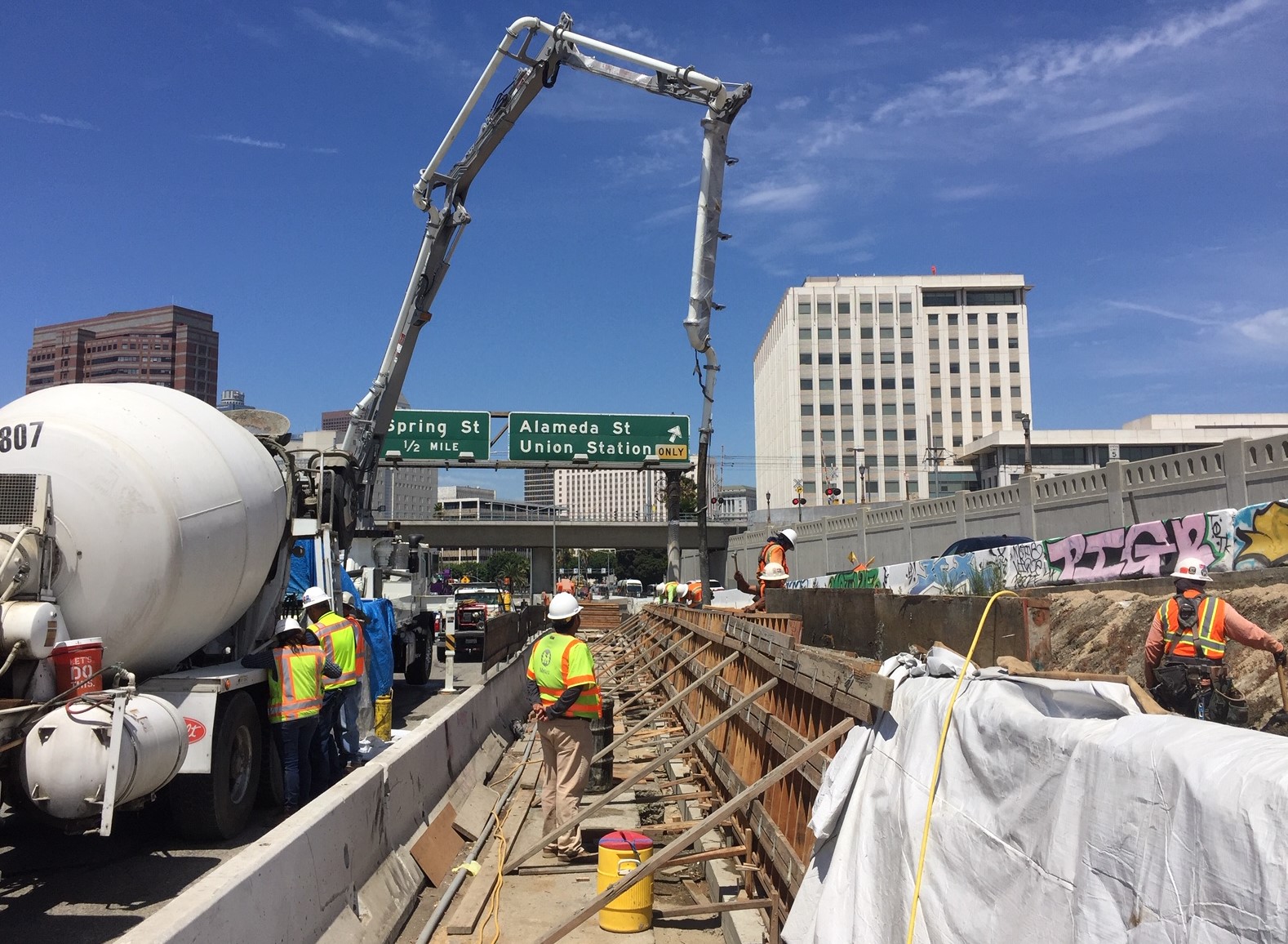This is the follow-up to my post of earlier this month on the Patsaouras Plaza Busway Station opening. Here I will give a brief update on the new station, and then trace the history of the project and its unbuilt predecessor.
Overall, the new busway station has been a success with riders, who are very appreciative of no longer having to endure the indignities of the old Alameda busway stop.
There was a minor issue with the station's displays, which at first showed the Foothill Transit Silver Streak as Route 707, a number solely used internally and unfamiliar to most patrons. This generated comments online, including by local transit advocate Erik Griswold on the Southern Cal Transit Fans Facebook group. Foothill noticed the comment and contacted Metro, which quickly fixed the issue. The displays now show the Silver Streak name was well as its number.
There have been a few instances of the elevators being briefly out of service. Foothill Transit has responded that “what we're hearing from Metro is that this is a start-up issue and should be resolved soon.” Metro Senior Executive Officer Timothy Lindholm noted that Metro is "still working out the kinks, but we will continue to make adjustments as needed based on the first weeks of operation.”
And that, my friends, concludes the status report.
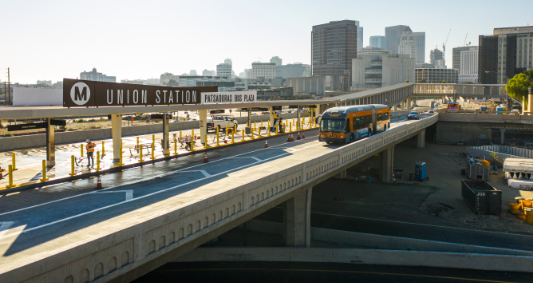
Now, go get some coffee or a mug of steaming hot cocoa (topped with marshmallows or whipped cream at your discretion) and settle in. I have a tale to relate - a tale of two projects, one unbuilt and the other beset by numerous challenges on the road to completion. It's a generational saga, much as in myth when Cronus gave way to Zeus; here an older project was in time supplanted by a younger one.
The younger is of course the new bus station. And the project it took the place of?
The Ramirez Flyover.
“The what?” you say. Even among Metro staff the latter is barely remembered and shrouded in mystery. To explore its origins one must go back - way back, to the very origins of Metro itself.
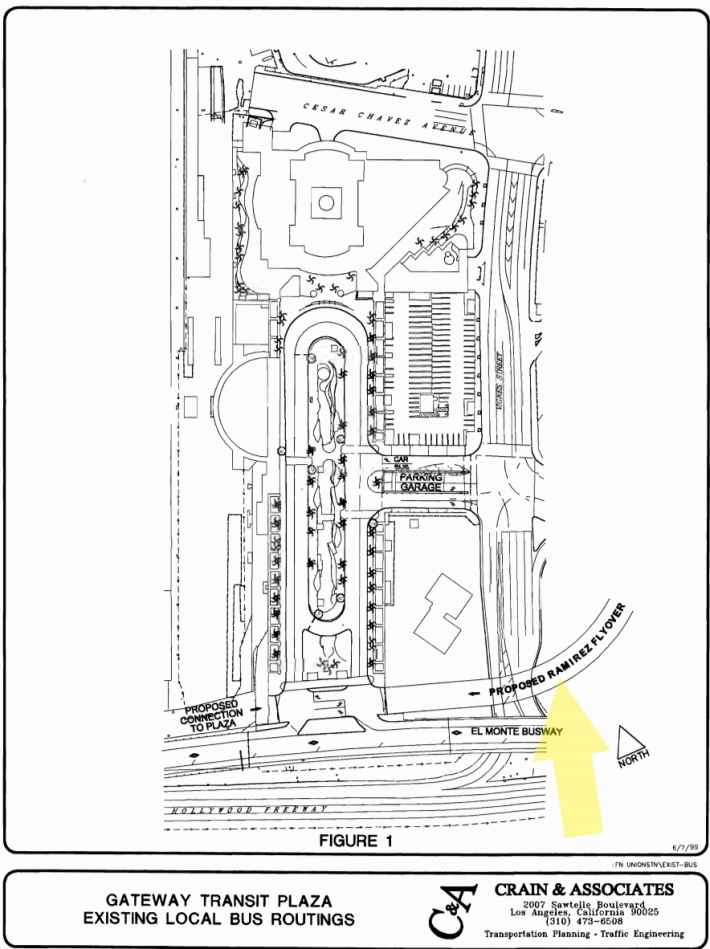
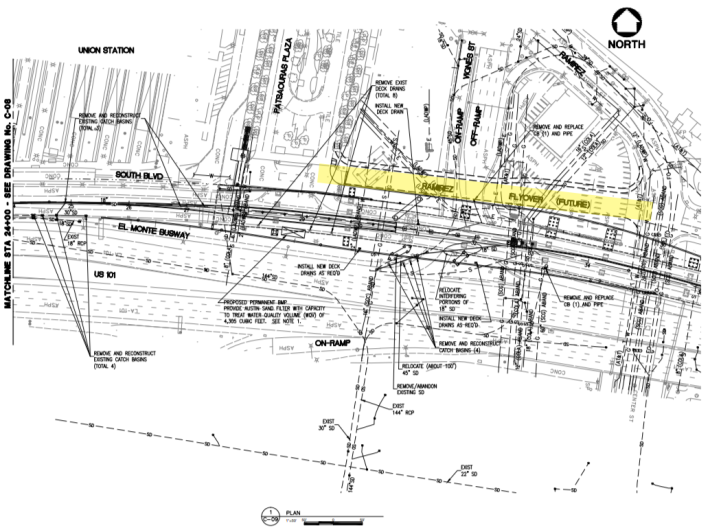
The flyover was to be located at the southeast corner of the plaza, soaring over Vignes Street before descending as it traversed what is now the southern end of the Denny’s parking lot to connect with Ramirez as it jogs east.
A staff report dated March 10, 1997 states: ”Completion of the Flyover will support effective operation of Patsaouras Plaza and the associated ‘kiss & ride’ facility by improving ingress and egress for buses and high occupancy vehicles.”
The same report provides the only explanation for the institutional impetus for the flyover (i.e. who got the ball rolling): “The City of Los Angeles’ Department of Transportation identified construction of the Flyover as a condition of approval for issuance of final tract maps and permits on the Union Station Gateway Project.”
Early on there was apparently a great deal of enthusiasm for the flyover. A project report dated October 1993 states that design was already sixty percent done, and a notice to proceed on construction was anticipated to be issued in October 1994. Estimated cost was $3 million.
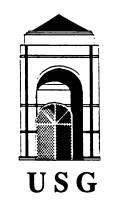
This report has the logo of Union Station Gateway Inc. (USG), which was a private nonprofit corporation established by Metro and Catellus Development Corporation pursuant to the Gateway Project Development Agreement for the purpose of providing design/build services for Metro Headquarters and the Gateway Transit Center. Catellus was the real estate development company (spun off from the Santa Fe Railroad) that then owned Union Station. The USG Board was evenly split between Metro and Catellus appointees, and its staff was drawn from the two partners.
Perhaps the Catellus contingent at USG was gung-ho for the Flyover, while Metro staff less so? Evidently something (fiscal realities? disagreement among the partners as to its necessity?) stalled progress, as the project languished for the next four years. Should one ascribe significance to the fact that the bulk of the aforementioned March 1997 report was actually a USG board report passed along to the Metro Board for its concurrence?
In the same report, a Metro staff summary states, “USG is seeking construction funding through the Call for Projects grant program.” Metro's Call for Projects is a competitive process that distributes discretionary capital transportation funds to municipalities, mostly cities. It is held every other year.
Formally Metro would be the entity that applied for that funding. USG was ineligible to do so, as it wasn’t a public agency. The application was successful and $2.868 million was awarded in 1997. But by then the estimated cost of the project was $5.028 million.
In 1999, the project got a boost in a Gateway Plaza Traffic Analysis report prepared for Catellus by Crain & Associates, a transportation planning and design firm.
The report is an analysis of plaza traffic and the impact on it from a potential southern roadway, known as the ‘upper-level roadway.’ The roadway evidently was another addition to the plaza promoted by elements of USG since the early 90s. It was to “connect the Plaza to Union Station to the west, and to the proposed ‘Ramirez Flyover’ to the east.” Despite extensive analysis, all that Crain & Associates could muster regarding the roadway was that it “will not cause significant adverse traffic impacts on bus operations within and adjacent to the Gateway Transit Plaza” - not exactly a ringing endorsement.
The report offers some common sense low-cost tweaks to make the plaza function more smoothly. Then rather oddly it states:
A final conclusion is that the Ramirez Flyover would go well beyond the benefits discussed above [i.e. the tweaks], not only by redirecting substantial volumes of traffic from other more congested areas around Union Station, but also by reducing overall bus traffic in the Gateway Transit Plaza. The Ramirez Flyover is truly a relief valve both for increased traffic growth in and around Union Station, and for some of the existing and potential worse problems that in the future may plague bus operations in and around the Gateway Transit Plaza.
This after the report barely mentioned the Flyover, and provided nothing substantive to support these claims of its necessity. Was this a plea by the Catellus contingent in the face of the continuing lack of progress the Flyover suffered?
July of that same year the Flyover’s Call for Projects award from 1997 was recertified, which would prevent Metro from giving those funds away to other projects. But it turned out the recertification did not signify there was fresh life in the project. A February 2000 Metro property inventory merely stated, “Project currently on hold.” In the same vein an April 2002 report states, “Construction of the Ramirez Flyover is currently on hold until funding alternatives are determined.”
When USG closed down in 2003, as part of the process of settling claims, Catellus agreed to build the flyover with its own funds, for up to $3 million. It was like Metro waving the 1999 report with its ardent advocacy in Catullus' face and declaring, “Fine! You want it so much, YOU BUILD IT!”
The current estimated cost to construct the flyover is within the $3 million proposed by Catellus. However, the actual cost may be higher pending final design and approval by the various oversight agencies such as the City of Los Angeles and Caltrans. If the cost were higher, Catellus would be responsible for any additional costs above the $3 million. Discussions are still underway with Catellus to resolve the disposition of the $3 million allocated to construction of the Flyover if for some reason the cost of the Flyover exceeds $3 million and Catellus is unable to obtain the additional funds required to complete construction. Agreement has been tentatively reached to place the $3 million in an interest bearing escrow account for up to a period of five years while Catellus seeks to obtain any additional funds needed to finance construction of the Flyover. The alternatives discussed include returning the funds to MTA for its unrestricted use or returning the funds to MTA for use designated for construction of the Flyover only. Discussions will continue until a resolution is reached.
In 2006 the project was given a further three-year extension to use its Call for Projects funding. But one senses in the language of the project description things were approaching the fish-or-cut-bait stage:
Due to budgetary constraints over the past few years, the project has been deferred. Metro Operations desires to proceed with the project. An extension is being requested to allow the appropriate parties involved to determine if the project is cost effective and, if so, to allow time to identify and secure additional funds to cover the projected shortfall.
Interesting, isn’t it? First LADOT throws its weight around, dumping the project in Metro's lap as a condition of signing off on the Gateway complex. Next Catellus, reflecting its impulse to build, pushes the project forward, but falls flat when it undertakes to build the flyover. Now Metro Operations takes up the mantle of supporter of a project with no clout behind it or seeming justification. Why? Maybe the folks on the bus side thoughts, “an extra entrance/exit for the plaza. Sure, why not? As long as we don't pay for it!” Which seems to be the theme of this project: all the passion evaporates in the face of sticker shock.
Meanwhile, evidently, behind the scenes there had been an effort to address access between the plaza and the adjacent El Monte Busway, and to do something about the busway's disgraceful and inconvenient bus stop at Alameda. Metro Board Member John Fasana spoke of this in his remarks at last month's ribbon cutting. He said that in 2007, when Metro was preparing its grant application to the federal government for the I-10 and I-110 HOT (High Occupancy Toll lane) demonstration project, Fasana's Chief of Staff Mary Lou Echternach pushed for Metro to include the busway station next to the plaza in that application.
Via email, Metro's Lindholm confirmed Ms. Echternach’s key role:
I can vouch it was definitely Mary Lou Echternach’s idea that germinated this station. She really wanted to explore making the connection, and based on her idea we did some planning-level internal studies to figure out how to do it. But what put it over the edge was her insistence on adding it to the ExpressLanes demonstration project. That’s when we got the first seed money to hire a planning/engineering firm to do the initial concept studies ...the rest is (many years of) history.
Metro's application to the feds didn’t get funded - until the New York legislature refused to even vote on a congestion pricing demonstration in New York City. Some of the $354 million being held for New York was instead redirected to Los Angeles.
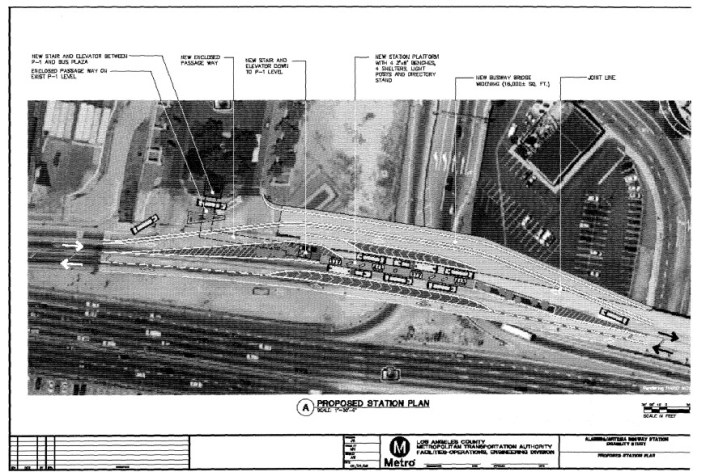
The Patsaouras Plaza Busway Station was a go! But this beginning was also occasion for an ending. In one paragraph of a February 2009 staff report the fate of the Flyover was sealed:
In the 1997 Call for Projects, $2.87 million... was programmed to the Ramirez Flyover project. The scope of the project was to improve El Monte Busway access to Patsouras Transit Plaza. Since that time there has not been consensus as to the necessary improvements and as a result, work was suspended. In 2006, the Board extended the original lapsing deadline on the Call for Projects grant to June 30, 2009 to provide an opportunity to define the project. Through the 2008 Call for Projects Recertification/Deobligation process, the Board authorized $325,000 of the grant funds to be used to evaluate design options that could result in a change in scope. Based on staff analysis, the Ramirez Flyover project is no longer needed, and the new proposed project is a far superior betterment to the capacity and operation of the Transit Plaza and the LA CRD [Congestion Reduction Demonstration] project. As such, we are recommending that the Ramirez Flyover project be cancelled and that the funds previously programmed be used to supplement the budget for this project. Operations, Planning, and the Real Estate Departments have been consulted and all are in agreement that this project meets the intent of the original grant [italics added].
It turns out all Catellus did in pursuit of building the flyover was spend $100,000 to determine it would cost more than $3 million. The remaining $2.9 million of the original $3 million was put in escrow for Metro. Now Metro proposed the remaining funding be reprogrammed from the cancelled Ramirez Flyover to the Patsaouras Plaza Busway Station. This was contingent on ProLogis, the company that in the interim had bought Catellus, giving permission for the escrow withdrawal.
The staff report was for construction work on both the busway station and the new and expanded El Monte Transit Center. A joint budget of $60.1 million was proposed, but without a breakdown as to the cost of the busway station alone.
The federal grant’s deadlines required the busway station to be completed by December 31, 2010! This extremely aggressive schedule is reflected in the October 15, 2009 staff report recommending a contract award to STV Incorporated for advanced conceptual engineering, bid support, and construction support services.
Even now the Flyover was not fully dead, as the report specified the scope of work for the station “may also include, dependent on right-of-way availability, feasibility, and budget, a flyover structure from Patsaouras Plaza to Ramirez Street, which would provide an alternate ingress/egress point for buses leaving/entering Patsaouras Plaza.” Does this thing have nine lives or what? Again no specific budget figure for the station is given.
A November 2010 status report on ExpressLanes said that the station project had completed significant milestones, with construction anticipated to start in the next twelve months and completion estimated by January 2012. But ominously, it also noted, “This project will be reviewed for de-scoping/de-funding due to the proposed shift of the alighting location due to grade issues.” Evidently the grade issues were resolved, as they were never mentioned again and the project progressed.
But in only twelve months the busway station construction hit its first snag. As excavation work began in El Monte, unforeseen soil contamination was discovered, and it had to be disposed of for construction to proceed.
What happened? A January 19, 2011 report explains:
Typically, environmental documents and preliminary engineering are completed prior to establishing a project budget. However, this action was required at an earlier stage to comply with the Memorandum of Understanding (MOU) with the United States Department of Transportation (USDOT) for the CRD program. No preliminary engineering or environmental work was completed prior to the budget being adopted in February 2009.
Things had been done in a rush and, as often happens, unforeseen conditions were discovered once work started. To meet the federal grant’s deadline, the agency authorized up to $6 million to get the contaminated soil removed ASAP. This meant the $60.1 million allocated for both the El Monte Station and Patsaouras Plaza Busway Station was no longer adequate.
In the fifteen months since it got a go ahead to proceed, the Patsaouras station had made substantial progress:
…preliminary engineering and the preliminary cost estimate are complete, and the design package is in the final Project Study Report (PR/PSR) approval cycles with Caltrans. Final approval by FTA of the NEPA/CEQA environmental documents is also contingent on this Caltrans approval. The budget estimate for the project at thirty percent design completion is $15.9 million.
Sounds great, doesn't it? We even have a budget estimate for the first time. But going forward, the report offers a note of uncertainty for the project and hints of possible delay:
Upon completion of the soil removal activities, the El Monte Station design documents and value engineering, and the final Caltrans approvals of the Patsaouras Plaza project, which are all forecast to be done by March or April 2011, staff will return to the Board with a re-forecasted project budget and a recommendation for proceeding, or not proceeding, with the Patsaouras Plaza project in its current configuration. In the interim, staff will continue working to achieve project approvals of the Patsaouras Plaza project, but will not advertise the design/build construction contract until we return to the Board [italics added].
It appears that the El Monte project had become the priority, and the Plaza station relegated to its shadow. And things were about to get even worse.
As outlined in an October 19, 2011 staff report, the El Monte soil decontamination cost soared, due to several further unexpected factors. The amount of soil and debris exceeded estimates. The disposal facility near the Salton Sea that had been planned to receive it closed early in the project, forcing Metro instead to transport soil to Yuma, Arizona, at twice the cost. Now that part of the project alone would need the entire $60 million budget meant for both, leaving the station out in the cold. Furthermore, our friends at the Federal Transit Administration (FTA) expressed concern about construction of the Patsaouras Plaza Busway Station possibly impacting the HOT lane (branded Metro ExpressLanes) demonstration by slowing down vehicles in those lanes. And the FTA also asked that the El Monte and Patsaouras Plaza stations have separate budgets.
As a consequence the station would be delayed:
…a constructability review has been completed which has two primary recommendations: (1) physical construction should not commence until the ExpressLanes demonstration project testing period is complete in January 2014, and (2) that schedule risks can be mitigated by progressing the drawings and specifications to 100 percent complete and obtaining Caltrans final approvals prior to construction. Using this new approach and construction start date, the project can be completed as soon as June 2015.
On the upside, “the FTA has also communicated with staff that completion of this transit improvement project is a critical component of the $210 million grant that is funding the ExpressLanes program, and as such, completion of the Patsaouras Plaza project is preferred by FTA.”
The expression of support encouraged Metro to submit, in July 2011, a grant application to the FTA. And on October 28, 2011 (a mere eleven days after the aforementioned report was heard by the Ad Hoc Congestion Pricing Committee) The Source reported that the FTA had awarded $9.6 million to Metro for the busway station. Another bit of good news was the project was going to keep the $4.9 million from the Call for Projects and the escrow fund. So even though in just nine months the estimated budget had risen nearly a million dollars to $16.8 million, Metro only needed an additional $2.3 million to fully fund the project.
Sounds rosy, right? But in my Streetsblog post on the delay I wrote: “What impact the recent FTA grant for the project could have on this timetable [to open by mid-2015] is unknown.” That question turned out to be very prescient.
On May 7, 2012 Metro issued for bids Design Build Contract No. C0970 for the Patsaouras Plaza Busway Station. Supporting documents included technical drawings, specifications and project definition.
Now came the true catastrophe. As I revealed in an October 18, 2012 Streetsblog post the three bids received were all too high, exceeding the estimate by forty percent! Regrouping, Metro undertook re-design and value engineering for cost savings. Construction completion was then estimated to be in Winter 2015.
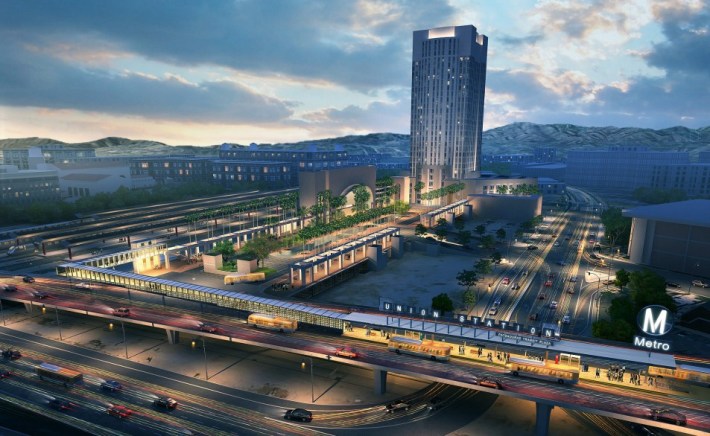
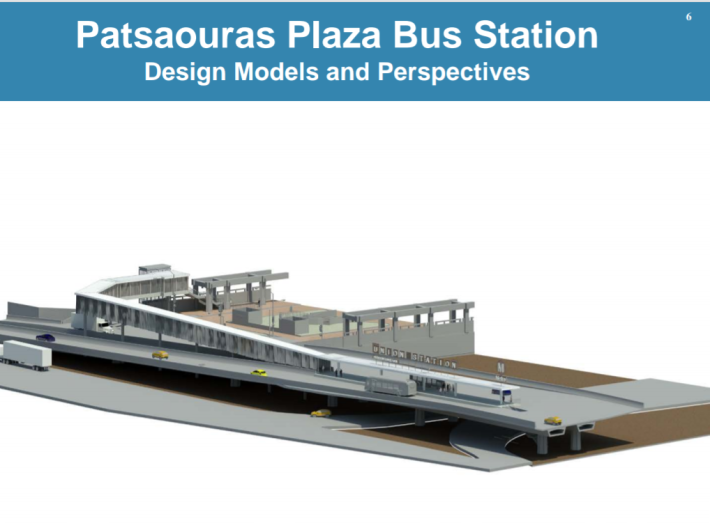
The re-bid process went fairly smoothly, with the design/build contract awarded in March 2014. By the time a presentation was made at the January 2015 Quarterly Service Council Meet and Confer the design was at sixty percent, construction was to commence in April 2015, and completion was forecast for October 2016. Also, sans explanation, the estimated budget had risen dramatically, to $30,984,000.
Things continued going forward fairly smoothly. Except, as a July 16, 2015 staff report explained, “OHL [the design-builder constructing the station] has required a higher than anticipated level of effort from STV [who did the conceptual engineering and design] to address questions related to the preliminary design and to assist with issues that require coordination with Caltrans.” The upshot was staff recommended an increase from $500,000 to $750,000 for design support during construction.
Daily News Reporter Mike Reicher, currently at the Seattle Times, in an Oct. 10, 2015 piece titled How One Metro Bus Station Could Be Years Late and Double the Construction Cost, stated the estimated cost had risen to $37.6 million! In just ten months it had increased by nearly seven million dollars!
The article claimed the chief culprit for the budget spike (as had occurred with the El Monte station project) was the deadlines dictated by federal grants. Work went forward without a thorough study of the project site and conditions. The Daily News paraphrased Lindholm: “The initial cost projection of $17 million was low because officials didn’t fully understand what they would have to build. Caltrans required Metro to widen the bridge and deepen the foundations.”
Another dent in the budget was due to a mistake by STV. In preliminary designs, the location of an existing Red Line subway service tunnel was incorrectly placed. Initial estimates for fixing the mistake were that it could cost upwards of six million dollars! In his Daily News article, Reicher asserted the error was all on Metro, since it approved the faulty plans before putting the project out for bid. The article mistakenly claims, however, that the design error involved the right of way for a possible future eastern extension of the subway. Lindholm confirmed, "The design issue was an EXISTING tunnel, Daily News just had it wrong. That said, we did also project for a future tunnel alignment going east. But that was not the cause of the design issue."
Groundbreaking slipped from April 2015 to (hopefully) January 2016, as Metro waited for the revised plans to be approved by Caltrans and various underground utilities provide clearances. Completion was then forecast for some time in 2017.
In March 2016, Metro staff informed the Board that instead of $6 million to correct the design error, it would cost $3,694,695. And, contrary to the Daily News article’s assertion that Metro had no recourse for reimbursement, “staff is in the process of evaluating and assessing an errors and omissions claim with the insurer [of STV] for full cost recovery.”
Staff also requested an additional $697,185 to facilitate a design change:
The [Patsaouras Plaza Busway Station] design originally included two lanes eastbound and one lane westbound from the proposed bus station. However, after further engineering and design review from Metro and Caltrans staff, it was determined that a two-westbound-lanes configuration is safer due to merge speeds when Metro buses and automobiles travelling on the High Occupancy Toll (HOT) lanes converge.
Construction was then anticipated to start April 2016 and be substantially completed by October 2017; the budget had risen slightly to $39,793,000.
With work about to commence, a laydown yard nearby for equipment staging and storage was needed. Metro actually owns the property [530 Ramirez Street] occupied by the Denny’s across from the Plaza. The agency purchased it in September 1993, originally for the initial segment of the subway [MOS-1 in Metrospeak] until the alignment was changed. It was then retained for the proposed Ramirez Flyover Project.
Now a portion of it was needed for construction of the station, to wit approximately 25,143 square feet of the Denny’s parking lot. The restaurant requested a ten percent reduction in rent for a two-year period as compensation for the loss of parking, as outlined in this February 16, 2017 staff report.
That same month, the monthly report on the status of major construction projects presented at the Metro Board Construction Committee gave as project’s status: “Demolition activities have started. Utility relocation and foundation work started in January 2017 with major construction work in February 2017.” Finally, Metro had shovels in the ground!
For the rest of 2017 progress was slow but steady. On March 16, 2017, the drilling of piles started. August 2017 the first concrete pour for bridge abutment was completed, along with sanitary sewer and storm drain relocations.
The January 2018 status report showed the project as 46 percent complete. After protracted negotiations, the contractor and agency agreed substantial completion of construction would be in December 2018. Ominously, it noted, “Pedestrian overcrossing and elevator foundations are pending Native bone resolution with Coroner.”
During the first half of 2018, progress continued. The February 2018 status report noted, “Pedestrian overcrossing design complete; elevator foundations pending redesign due to garage conflict.” By the June 2018 status report, the project was sixty-four percent complete, the completion date had slipped to March 2019, and “all concrete deck pours completed, all falsework removed.” Falsework is a temporary support structure, often of wood, to assist load bearing until the structure is capable of supporting itself.
Also as of May 17, 2018, all construction activity had been suspended.
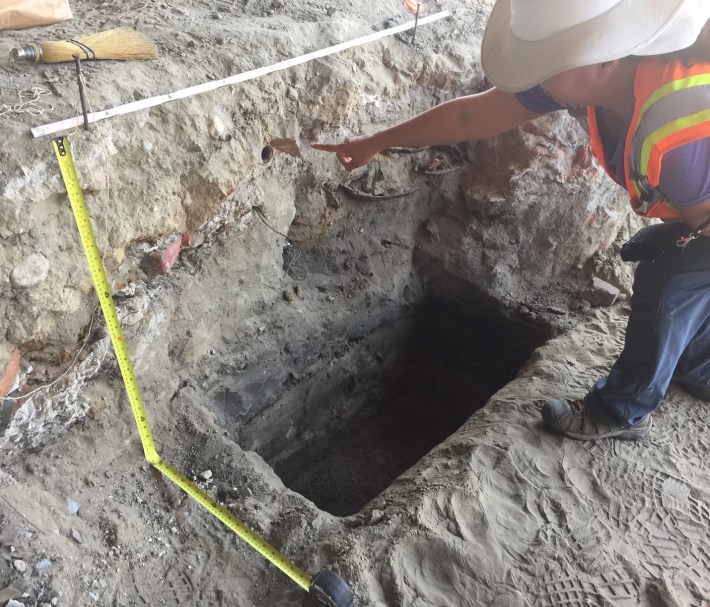
What happened? Beginning with the initial uncovering of Native American remains in January, as excavation continued more remains along with archeological features were uncovered. As an August 6, 2018 memo to the Metro Board explained, the extent of discoveries had been unexpected:
[The] project site has been extensively disturbed in the past by the Southern California Gas Company's Manufactured Gas Plant, Caltrans 101 freeway, El Monte Busway Bridge, the Metro Red Line, and Patsaouras Plaza, among others. The previous construction activities mentioned have disturbed or removed intact sediments and the probability of cultural resources being preserved was considered low.
Instead Metro's fairly limited area excavations discovered thirteen "archaeological features." By the time work paused, construction had uncovered human remains, some of which were Native American. "The [Federal Transit Administration] opined that the nature of the [Patsaouras Plaza Busway Station] site was unique and considered it one of the most archaeological resource rich sites in Los Angeles County, requiring oversight by specialized government agencies and Native American tribes.” Agreements, consultations, plans, and studies commenced.
Metro soon received permission to proceed, "with very limited construction work within non-sensitive areas. This work is not on the critical path for the project, but was started July 16th and expected to be completed by August 31st.”
The hope then was that construction could restart in approximately January 2019. Despite efforts by the involved parties to expedite the process, construction did not resume until May 13, 2019. The delay was attributable to the extent of what was found beyond the initial thirteen features and remains. In total, 37 archaeological features, including several human bones, were discovered. The bones uncovered were determined to be from a medical training facility, likely not a burial site. Most bones found were not native, but some were. Nonetheless, it was important to respectfully re-inter them via approved processes.
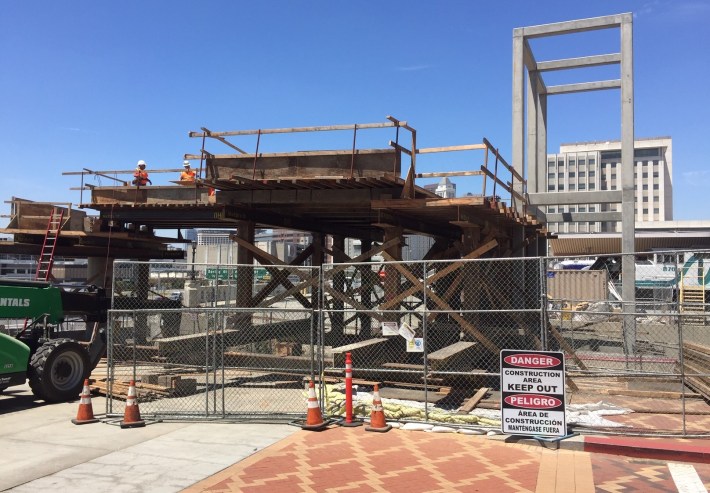
A staff report dated May 16, 2019 provided a summary of the challenges that resulted in the delay:
The Patsaouras Plaza Busway Station (PBPS) project is among the most complex design, construction, and construction management activities undertaken by Metro. It is being built in a small, congested area with ongoing street, freeway, and transit operations. This was exacerbated by the fact that PBPS scope, schedule, cost and quality were strongly influenced by historical and archeological discoveries to the extent not experienced in recent memory on a Metro project.
Due to the delay, along with additional costs and the settlement of contractor claims, a budget increase of $11,120,000 was necessary, bringing the total cost to $50,913,000. Estimated project completion was then May 2020.
The June 2019 status report detailed that, once construction restarted, some of the initial work included pouring the emergency stairway exit and columns for the elevator structure, plus “canopy foundation construction.” Project progress was at 65 percent.
Progress through the remainder of 2019 was steady - as detailed in the monthly status reports:
- July 2019: "Archeological and Native American monitoring continues. Foundation work for the pedestrian overcrossing, busway canopy, elevator and walkway is ongoing." "Human remains continue to be discovered requiring focused monitoring impacting construction."
- September 2019: 70 percent complete, “Archaeological and Native American monitoring continues. Foundation work for the pedestrian overcrossing, busway canopy, elevator and walkway are complete.”
- October 2019: 75 percent complete, "False work for the pedestrian overcrossing, elevator platform and walkway are complete.”
- November 2019: Archaeological and Native American monitoring had concluded as excavation was complete. “Rebar installation for the pedestrian walkway, overcrossing and elevator platform begin.”
After the holiday break work re-started and continued its slow but steady pace:
- January 2020: 80 percent complete, “Concrete has been poured for the pedestrian walkway and overcrossing, and rebar has been completed for the station and elevator platform. Pedestrian walkway overhead steel is in progress.”
- April 2020: 85 percent complete, “Elevator enclosure glass completed. Pedestrian walkway interior stainless steel panels initiated.”
- June 2020: Still approximately 85 percent complete, “Consultation initiated regarding the Treatment of Human Remains recently discovered during contour grading. Elevator installation started. Stainless steel panels 90 percent complete. Emergency egress poured. Canopy columns installation pending resolution of non-conformity.”
- August 2020: Still approximately 85 percent complete, “Substantial Completion is anticipated to be delayed to late Summer 2020 due to recent archaeological discovery, data recovery, and IT/Communication equipment assembly and delivery delays.” "Canopy column completion pending resolution of corrosion protection issues."
- September 2020: 90 percent complete, "Canopy columns installed and bus platform poured." "Archeological investigation completed and storm drain installed." "P1 elevator concrete poured."
It was announced the station would open on September 27, only to have it postponed due to, according to Metro CEO Phil Washington, revised state elevator codes.
The actual opening was on November 1.
Even this late in the process, things were still being straightened out as the October 2020 status report mentioned "outstanding contractual disputes resolved with contractor.”
The campfire no longer burns brightly, hardly more than glowing embers. In the flickering light the ring of listeners can barely see the storyteller. From the outlined shadow a voice speaks. Whether it is a tale told of Gilgamesh, Quetzalcoatl, the Raven or the Ramirez Flyover and Patsaouras Plaza Busway Station, when finished there is a coda to what has been told. For at journey’s end comes the wisdom earned by the path trod and its twists and turns. A story is not merely a recitation of sights and sounds but a means by which lessons are shared and truths revealed.
Honestly while composing this piece I kept trying to wrap my head around the ebbs and flows of the flyover project. There was something going on that I was missing. It annoyed and vexed me. Until one afternoon in a flash of insight I realized what it was. This was about a collision of institutional outlooks within the USG. Metro as a transit agency only cared about whether there was a problem with buses getting in and out of the plaza. To it, the flyover was the solution to a nonexistent problem. But for Catellus as a development company, the impulse is always to build and keep building. Whether a project is actually needed is often low on the list of priorities driving developers. When the showdown came, Metro called Catellus’ bluff and it folded rather than spend its own money to make the flyover a reality.
The flyover epilogue will be with the planned Link Union Station run-through tracks project. The plaza could effectively be moot with a major Union Station reconfiguration in the offing.
Summing up the busway station project lesson is a much easier proposition: stuff happens. The other takeaway is that deadlines that often come with federal funding can cause a project grief by forcing work to start without adequate preparation. It was one of the factors that has hobbled the California High-Speed Rail project and it certainly happened with both the El Monte station and Patsaouras Plaza Busway Station projects. I can’t venture a guess what the solution to this problem is.
My thanks to Timothy Lindholm and Mary Lou Echternach for the illuminating project background information they shared which enhanced this piece.
Dana Gabbard is a longtime transit rider, treasurer of Southern California Transit Advocates (SoCaTa), and a 2011 Streetsblog Streetsie Award winner. For more than a decade, he has written articles for Streetsblog Los Angeles.
